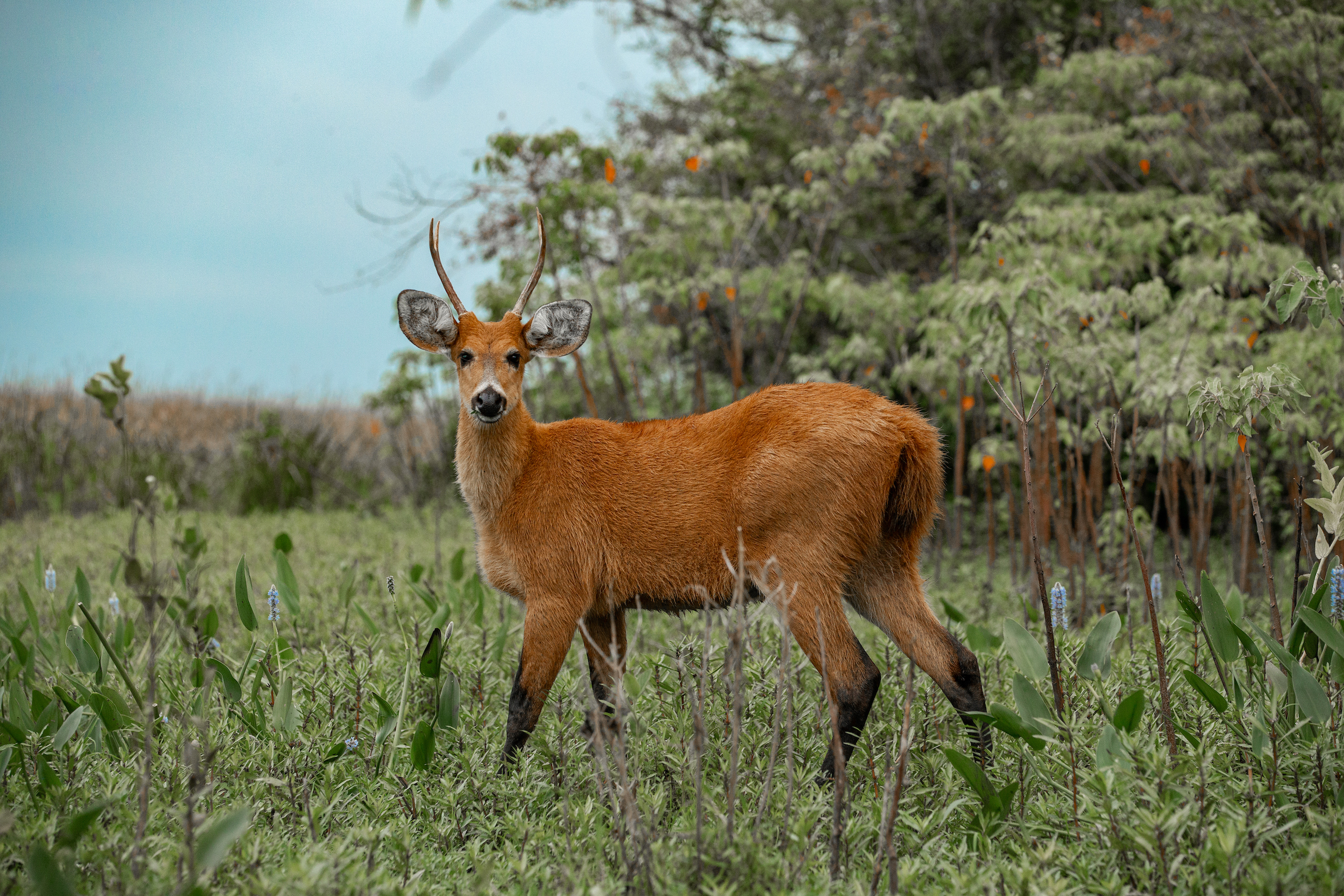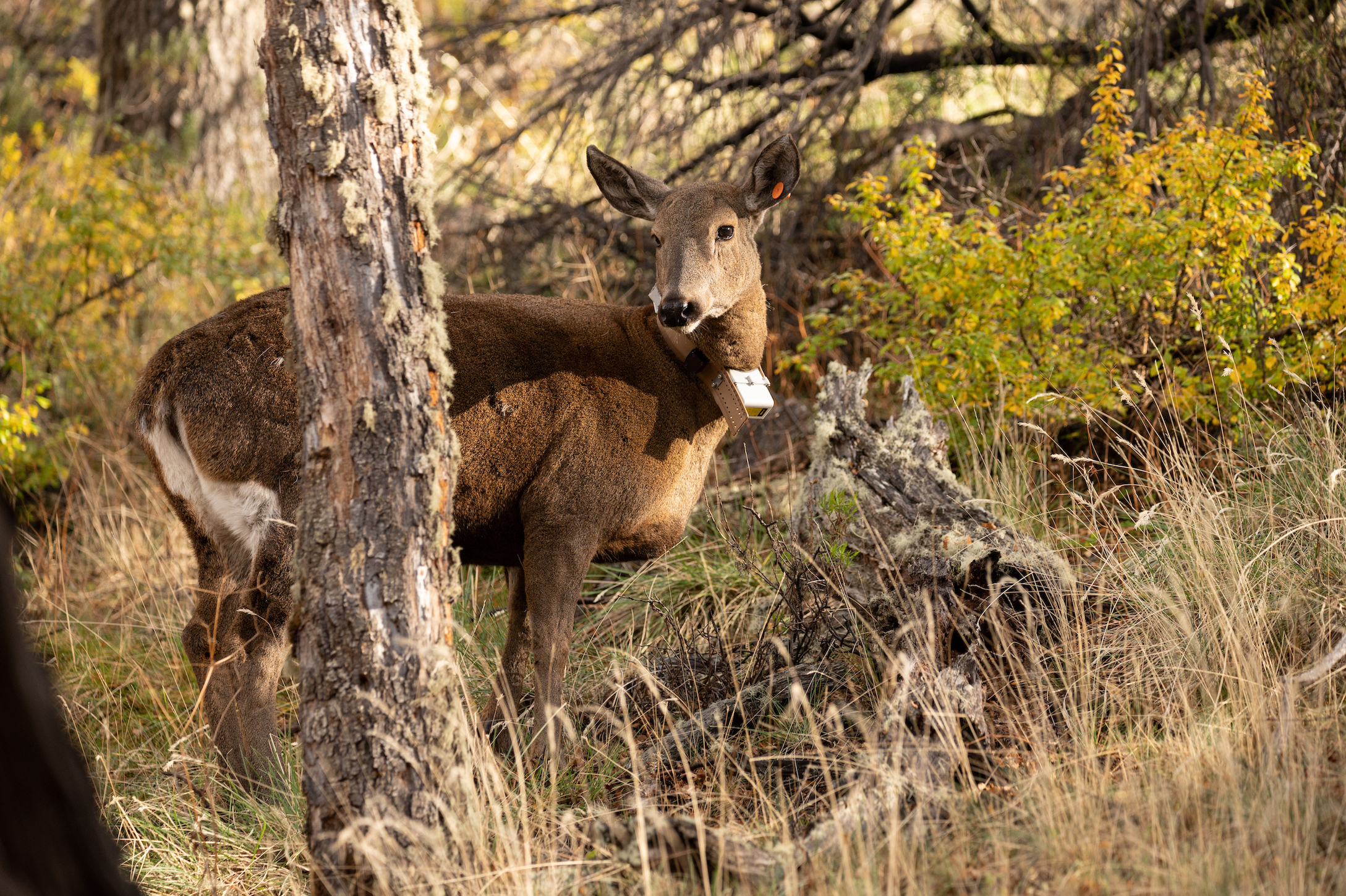- Large mammals play crucial ecological roles by influencing the behavior of other animals in the food chain and shaping the structure and composition of their environments.
- A new study that looks at global opportunities for the restoration, reintroduction and rewilding of large mammals across the world’s terrestrial ecoregions found that just 15% of the world’s land area supports intact large mammal assemblages.
- The study suggests that returning just 20 large mammal species to their historic habitats could restore intact large mammal communities across almost one-quarter of the Earth’s land area.
- The scientists behind the study recommend large mammal rewilding be incorporated into area-based conservation targets being considered under the Convention on Biological Diversity’s Post-2020 Biodiversity Framework and into restoration efforts under the U.N.’s Decade on Ecosystem Restoration 2021-2030.
The reintroduction of gray wolves to Yellowstone National Park in 1995 triggered a cascade of knock-on effects. The wolves kept herbivores like elk in check and on the move, reducing their browsing pressure on young trees. As a result, groves of willow and aspen sprouted along watercourses, creating ideal conditions for a thriving beaver population. The busy beavers in turn engineered wetlands where a diversity of fish, songbirds and invertebrates flourished. In short, the return of the top predators transformed the U.S. national park into a biodiverse, fully functioning, carbon-sequestering ecosystem.
Now, a new study suggests that restoring just 20 large mammal species to their historic habitats could similarly revitalize ecosystems and boost biodiversity across almost one-quarter of the Earth’s land area.
The international team of researchers behind the study assessed global opportunities for the restoration, reintroduction and rewilding of intact large mammal assemblages across the world’s terrestrial ecoregions, geographic areas characterized by similar plant and animal communities. They published their results in the journal Ecography.
In addition to the seven predators and 13 herbivores identified as key focal species, the researchers highlight the 30 high-priority ecoregions where large mammal rewilding is most feasible and would lead to the most significant biodiversity gains.
“There are opportunities not only in the wilderness of Amazonia or the remote Arctic, but also in dry forests or in deserts,” Carly Vynne, study lead author and program director of the biodiversity and climate team at U.S.-based NGO RESOLVE, told Mongabay. “There’s really an opportunity to conserve these unique and amazing [large mammal] assemblages in all sorts of places.”

A critical decade for nature
Large mammals, ranging from apex predators like the Yellowstone wolves to medium-size carnivores and herbivores, play vital roles in the environments they inhabit. They influence everything from the behavior of other animals in the food chain to the diversity and structure of vegetation, and the abundance of rodents and invertebrates.
Moreover, studies have found that areas with intact large mammal assemblages typically store more carbon. And by preying on animals in poor physical condition, large predatory mammals reduce the prevalence of pathogens in their environment, thereby reducing the likelihood of pandemics.
Restoring complete large mammal assemblages to areas where they’ve been lost due to habitat destruction or overhunting adds a critical missing dimension to area-based conservation targets being considered under the Convention on Biological Diversity’s Post-2020 Biodiversity Framework, according to the study.
Such goals as the 30 by 30 initiative, whereby countries have pledged to protect 30% of their land area by 2030, should include directives for species reintroduction, according to rewilding advocates. Experts are also calling on wildlife recovery to be incorporated into the U.N.’s Decade on Ecosystem Restoration 2021-2030 to ensure full ecosystem integrity conservation worldwide.
“We can set aside habitat, but if we’re doing it in places where the wildlife has been depleted or defaunated … we’re just setting aside scenery,” study co-author Eric Dinerstein, director of the biodiversity and wildlife program at RESOLVE, told Mongabay. He said restoration efforts must be “ecologically based” and involve not just planting the native trees that used to be there, but also returning the animals that have gone extinct. “We have to really focus on bringing back those key elements of the ecosystem: the landscape engineers like rhinos and elephants, and the top predators: the tigers, lions, jaguars, polar bears, grizzly bears,” he said.

Priority species and areas for conservation
For their study, the research team first set out to establish where intact large mammal assemblages can still be found on Earth. They compared present distribution data for 298 species with estimates of where the animals lived in the year 1500, finding that just 15% of the world’s land area still supports complete assemblages.
Most of these areas are safeguarded by virtue of their inaccessibility or through direct protection and conservation. For instance, intact assemblages were found in remote boreal regions, in landscapes stewarded by Indigenous communities in the Amazon and eastern Africa, and also in parts of Asia, Europe and the western U.S. where intensive conservation measures have proven effective.
“We should consider what’s going right in those places, and look to cases where restoration has happened and it’s been successful,” Vynne said.
Next, the researchers calculated that restoring just 20 of the 298 large mammal species to their historic ranges would boost coverage of complete large mammal assemblages from 15% of Earth’s land area to 23% — a range increase of more than 11 million square kilometers (4 million square miles). Nine of the species are globally threatened; seven are predators, including jaguars, wolverines and pumas; and 13 are herbivores, such as Pampas deer, hippos and gazelles.
Finally, they looked at where large mammals could be feasibly restored within the next five to 10 years by examining ecoregions missing just one to three of their historic large mammal species. From these areas, they pinpointed 30 high-priority ecoregions where recovery efforts are underway or where sufficient habitat remains to accelerate rewilding over the next decade. A total of 16 of these priority regions require only one species to complete their large mammal assemblages.

While large tracts of natural habitat remain within the priority ecoregions and range of the 20 key species, the researchers acknowledge that large mammal restoration would only be feasible once the causes of their previous decline had been addressed.
“Our recommendations may not be suitable everywhere on the ground just yet — local assessments will judge if, for example, hunting pressures or lack of an adequate prey base mean other issues need addressing before initiating a reintroduction programme,” study co-author Joe Gosling, program officer at the U.N. Environment Programme’s World Conservation Monitoring Centre (UNEP-WCMC), said in a press release. “However, our findings show there are huge areas of the world that could be suitable for large mammal restoration, if mitigating factors are managed.”
According to the study, reintroducing Eurasian beavers, European bison, reindeer, lynx and wolves to Europe would complete large mammal communities across 35 ecoregions. In Africa, reintroductions of hippos, cheetahs, topi antelopes, African wild dogs and lions could more than double the regional coverage of intact large mammal assemblages. Over in South America, restoring jaguars, pacaranas, Pampas deer, marsh deer and white-lipped peccaries would increase the range of whole assemblages by hundreds of thousands of square kilometers.
The researchers also recommend the implementation of a new “Wildlife Recovery Index” to create a coordinated way of tracking progress toward restoration goals. In addition to helping identify potential landscapes and species for restoration, the Wildlife Recovery Index would take stock of three main factors: habitat protection, such as protected areas and wildlife corridors; management interventions, such as reintroduction, anti-poaching and human-wildlife coexistence programs; and enabling policies that promote rewilding and coexistence.

Rewilding in practice
The new study provides an important “big picture” global overview of where rewilding and species recovery efforts would have the best chance of restoring intact mammal assemblages, according to Cole Burton, a terrestrial mammal conservationist at the University of British Columbia in Canada.
“Having such intact assemblages is a hopeful and inspiring conservation goal,” Burton, who was not involved in the study, told Mongabay in an email. “Implementing it could show us what is possible in terms of human-wildlife coexistence in the Anthropocene, as well as help highlight the ecosystem functions and services that these mammal communities provide — including the cultural services that may benefit local and global communities.”
However, the success of rewilding efforts will ultimately depend on dedicated local conservation efforts, according to Burton. A major challenge will be working with communities in rewilding landscapes to promote coexistence. “These species require large tracts of high quality habitat, typically with low human disturbance, and in many cases they may present daunting practical challenges to overcome in terms of conflict with people,” Burton said.
But overcoming these challenges is possible. The new study cites several examples of science-based projects that, through sustained involvement of local communities and governments, have successfully restored large mammals to their former landscapes. For example, a transboundary network of 14 protected areas connected by community-managed wildlife corridors across Nepal and India has led to the recovery of regional tiger numbers.

In South America, Rewilding Argentina, with support from Tompkins Conservation, have returned five of the new study’s 20 key large mammal species to the Iberá wetlands in Argentina’s Corrientes province. Their efforts to rewild jaguars, pumas, Pampas deer, marsh deer, huemul deer and many other mammals and birds owe much of their success to community outreach and education.
“We improve the conditions for rewilding through environmental education and communication, but above all by changing the economy of the territory [from] extraction of natural resources (livestock, agriculture, forestry) to a service-based economy with wildlife watching and nature-based tourism,” Sebastián Di Martino, conservation director at Rewilding Argentina, told Mongabay in an email. “In this shift, the species (including large predators) cease to be a problem for most, instead it becomes an opportunity for development.”
Last year, jaguars were released into the Iberá landscape for the first time in 70 years. Di Martino and his colleagues are now collecting data to assess their interactions with native herbivores as well as knock-on impacts on scavenger abundance, threatened grassland birds, and vegetation recovery.
“These very charismatic species of large mammals … generally have great cultural importance, so with their recovery we not only heal ecosystems but also restore a sense of identity,” Di Martino said. “The places where rewilding takes place become more and more well known, so the locals’ pride in their homeland also increases.”
For Dinerstein, the most “astonishing revelation” of his career as a biologist is just how rapidly large mammal numbers rebound once pressures are reduced. He cites the recovery of tigers in India and Nepal. Tigers breed faster than their prey, he said, therefore so long as there is sufficient prey, tigers will come back “almost overnight” if we don’t persecute them.
“We have examples of just how rapid this restoration could be, if we only put our minds to it.”
Banner image: Tobuna, the first jaguar to join the Jaguar Reintroduction Center in Iberá Park. Image © Rafa Abuin-Rewilding Argentina
Citations:
Vynne, C., Gosling, J., Maney, C., Dinerstein, E., Lee, A. T., Burgess, N. D., … Svenning, J. (2022). An ecoregion‐based approach to restoring the world’s intact large mammal assemblages. Ecography. doi:10.1111/ecog.06098
Dinerstein, E., Joshi, A. R., Vynne, C., Lee, A. T., Pharand-Deschênes, F., França, M., … Olson, D. (2020). A “Global Safety Net” to reverse biodiversity loss and stabilize Earth’s climate. Science Advances, 6(36). doi:10.1126/sciadv.abb2824
FEEDBACK: Use this form to send a message to the author of this post. If you want to post a public comment, you can do that at the bottom of the page.
